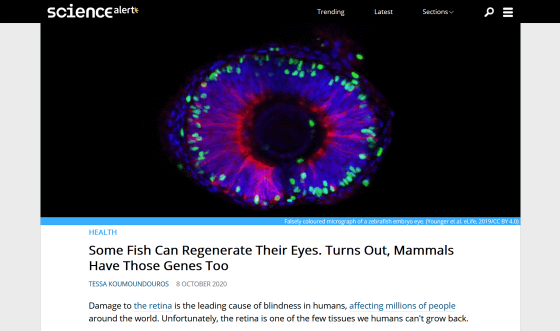It turns out that mammals also have 'genes that regenerate the retina'

Gene regulatory networks controlling vertebrate retinal regeneration | Science
https://science.sciencemag.org/content/370/6519/eabb8598
Johns Hopkins Scientists Find Mammals Share Gene Pathways That Allow Zebrafish to Grow New Eyes
https://www.hopkinsmedicine.org/news/newsroom/news-releases/johns-hopkins-scientists-find-mammals-share-gene-pathways-that-allow-zebrafish-to-grow-new-eyes
Some Fish Can Regenerate Their Eyes. Turns Out, Mammals Have Those Genes Too
https://www.sciencealert.com/mammals-have-the-same-gene-pathways-that-let-zebrafish-grow-new-eyes

Although humans cannot repair damaged retinas,
Muller cells , a type of glial cell that support the retina, play an important role in retinal regeneration in animals. Muller cells are also present in the mammalian retina, usually cleaning neurotransmitters and other debris, storing important molecules, physically supporting retinal cells, and optionally in the immune system. It has the ability to ask for help.
When the retina of animals with regenerative ability such as zebrafish is damaged, Muller cells receive light stimuli in the retina. Major cells such as cone cells , rod cells , and optic nerve that connects to the cerebral brain. It is known to differentiate into and regenerate the retina.

by
Previous studies have shown that humans share 70% of their genes with zebrafish, and that some of the shared genes are related to retinal regeneration, but humans have a function of retinal regeneration. I can't. To find out why, the team conducted an experiment to observe how Muller cells react by damaging the retina of zebrafish, chick, and mouse.
As a result of the experiment, it was found that immediately after the retinal injury, a gene was expressed in Muller cells of all animals to contain the injury, clean the tissue, and attract immune cells to fight potential invaders. The fact that Muller cells behaved in the same way in all animals surprised the research team.
However, over time, the Muller cells of each animal behaved differently. In zebrafish, genes related to cell maturation were activated, returning Muller cells to a more primitive state and differentiating into the various cells that make up the retina. On the other hand, in chicks, only a part of the gene was activated and showed much lower regenerative ability than zebrafish, and in mice, Muller cells did not differentiate into retinal cells.
As a result of the analysis, it was found that the production of nuclear factor I , which acts as a transcription factor, was stopped in all animals after retinal injury, but the production was resumed at a relatively early stage in mice. According to the research team, nuclear factor I has a function to block the regenerative ability of Muller cells, and when the production of nuclear factor I is inhibited, Muller cells begin to differentiate into retinal cells even in mice. Stated.

The results of this study suggest that animals have the ability to regenerate the retina by default, and that the ability to regenerate was inactivated during evolution. Professor
The researchers suspect that there is a trade-off between central nervous system regeneration and resistance to pathogens as to why mammals have lost their ability to regenerate the retina. Glial cells, including Muller cells, help limit the spread of pathogens, so they are capable of regenerating in animals that are prone to disease in the brain and nervous tissue so that they do not differentiate into other cells and lose resistance to the pathogen. It may have been inactivated.
'We know that certain viruses, bacteria, and even parasites can infect the brain. Infected brain cells can grow and spread through the optic nerve,' Blackshaw said. If so, it could be disastrous. '

Related Posts:







